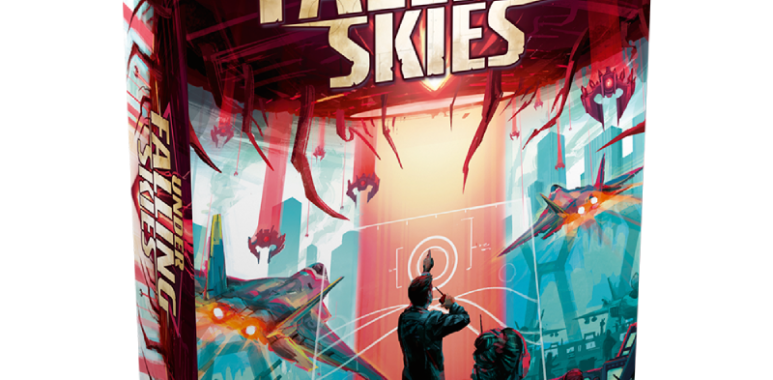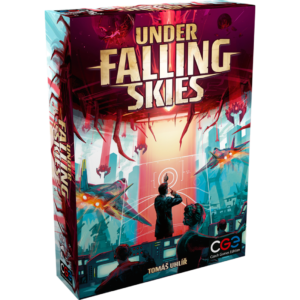
Under Falling Skies: How a game originally consisting of only 9 cards became one of the most awaited titles of the year
Almost exactly the day 45 years ago Space Invaders was released in Japan. One of the most recognizable games of all time. Not only brought it dynamic difficulties to the realm of video games but was also a major success for it’s intuitive gameplay. No wonder many companies brought it from the arcades to their home consoles. In reminiscing on that legendary game we would like to show you the fourth designer diary of the Space Invaders inspired board game Under Falling Skies. This diary was originally written by Tomas Uhlir.
You are facing an alien invasion. Hiding in a base below the city, you must defend yourself long enough to research a weapon and repel the enemy.
Under Falling Skies is a dedicated solo game for 20-40 minutes that uses a unique dice-placement mechanism. Place dice on rooms in your base to perform various actions, but for every die you place, the enemy in the same column moves towards the base. Higher dice rolls give you more powerful actions, but also make the ships descend faster.
Use your jet fighters to shoot down the enemy, maintain the energy supply, install robots, and expand your base — but don’t forget about the research, which should be your priority.
Enemy fighters are not the only threat you face, however. The mothership slowly descends towards the city and will eventually crush you if you are not able to finish the research in time.
Under Falling Skies is a game published by Czech Games Edition (CGE) in 2020 — but it started as a freely available 9-card print-and-play solo game.
Those of you who have been following Under Falling Skies more closely probably know that I wrote a few designer diaries already. I focused primarily on the changes between the print-and-play predecessor and the published version. They describe some interesting production ideas, graphics and user interface improvements, and the approach with the campaign.
But I still have an interesting story to share. How did it happen in the first place that a game consisting of only nine cards and designed with no publishing intention in mind became one of the awaited titles of the year?
BGG Print-and-Play Contests
It all started around January 2019 when I once again decided to enter the 9-card print-and-play design contest. In case you haven’t noticed, at least a dozen similar contests happen every year on BGG. They are run by great enthusiasts, and they have an amazing community of print-and-play players and passionate designers around them. All the games are free to download, and it is assumed that people will print them themselves. Probably because the games from the 9-card contest are very easy to build, this particular contest is one of the most popular out there.
Designers of these contests actually take the role of the whole publishing team. You not only design the game, but you need to playtest it, take care of all the illustrations and graphic design, write the rules, and do the typesetting and proofreading — but all this is still not enough because there are around 100 other games in the contest, and you need to make your game stand out in the competition, so you touch the marketing side as well by starting the “work-in-progress thread”, where you write about the game, hoping to attract enough players to get some desirable feedback. Oh, and you have about two months for all of this, working mostly during evenings after work, so as you can imagine, it’s a very intense process. Believe it or not, there are even designers who enter with two games at once!
To make these contests more interesting, most of them come with some kind of restriction. In the 9-card contest, the game can have only nine cards, plus up to 18 other common components: six-sided dice, cubes, tokens, etc. The design all needs to fit to one double-sided sheet of paper so that it’s easy to print, but there are also 18-card or 54-card contests that don’t allow components other than cards. Some contests are built around the number of players, like a two-player contest or — one of the biggest — the solitaire game contest. But you can stumble upon even more challenging restrictions like 1-card, 1-page, Postcard, Mint Tin, Video stream, 24-hour, etc.
I strongly recommend that aspiring designers try at least one of these contests. It’s a great opportunity to go through the whole process of designing a game. The restrictions don’t allow you to make it too big, so it stays manageable. However, the restrictions have also another big advantage: They force you into the most unique and creative solutions.
I will end this small detour by reminding you how great the BGG community really is. While the designers compete, they also playtest one another’s games, provide feedback, make design suggestions, proofread other’s rulebooks, and sometimes even help with the art. For me, it’s this friendly community that makes it really special.
Initial Design
But back to Under Falling Skies. I had already participated in the 9-card contest in 2017 with a two-player game called First Snow, which ended up winning that year, so I had a pretty good idea of what entering the contest involved. However, when looking back at First Snow, I must admit that making a deeper multi-player game with only nine cards was probably a bit too ambitious. Equipped with that experience, I decided to go for a solo game this time.
I have to confess that at that time I had very little experience with solo games, but I took it as a challenge to design a solo game that I would enjoy playing. I realized that when there are no other players, the game itself needs to provide a satisfying challenge. Many solo games mimic the structure of multiplayer games by altering player turns with AI turns, the latter of which are mostly resolved by some kind of deck or instruction table, but I wanted to avoid any artificial AI rules or long upkeep phases.
Since you are the only player, you should play the vast majority of the time. The enemy actions should be closely tied to what you do, ideally with your own moves creating the challenge.
Once I decided upon a dice-placement game, the core idea emerged: The placed die’s value determines both the strength of your action and the reaction of the enemy. This approach also solves the problem with dice games in which some rolls are simply better.
By that time, I was playing with the idea of designing a tower defense game, and this mechanism would fit it perfectly. The enemy would move towards your base based on the value of a die you place. After a short brainstorming about the theme, the Space Invaders inspiration emerged.
I won’t go into much detail about other design decisions, but to my great surprise, the whole process from the initial idea to the first working prototype was really fast. I recall that I had been thinking about the details for a few evenings, doodling some sketches into my notebook and waiting for the weekend to make a prototype.
The first prototype was really rough, but as you can see, mechanically it hasn’t changed much from the final version. All the core concepts are there: the drill, descending mothership, re-rolling dice, how research works, robots, the AA-gun rooms, etc. In the next iteration (about two hours later), I added room modifiers and the mothership effects; the main reason for them was to ensure that the player wouldn’t forget to move the mothership at the end of each round.
Looking back at it, it still feels unbelievable how fast it all clicked. Even the very first game was fun and challenging to play, in contrast to the usual design process when it takes weeks or even months before you get at least a little playable game. I spent another week or two with details and balancing before I submitted the first prototype version to the contest.
And people liked it. Only a few tried it at first, but it kept spreading. At one point, I made a collage from various builds that people shared with me.
Joining Czech Games Edition
While I was working on the game for the contest, an opportunity emerged to work for CGE. I took it immediately as it was a secret dream of mine, after all. These were a super intense two months as I was working on Under Falling Skies, while quitting my previous job (as an interior designer) and starting to work for CGE.
Czech Games Edition stages a regular yearly gaming event called “Czechgaming” which is an opportunity for all employees to meet, playtest the upcoming games, and try new prototypes. I took Under Falling Skies with me, just to take the opportunity to playtest it — and you know what, it got played quite often. People were curious about that unusual tiny game, solo on top of that. I remember a really nice moment when people came to me one morning to tell me how they got an urge to try the game, then played until 3 a.m., and they wanted to let me know how it went. Word started to spread that CGE should publish it.
I should explain how it is usually decided in CGE which games are going to be published. Everyone is supposed to give their opinion, so that it will be clear that enough people are enthusiastic about the game, willing to work on the development, playtest it, go through the necessary iterations, etc. It’s basically a joint decision by the whole company.
Soon after, the results of the 9-card contest came out. Under Falling Skies won not only the main category, but came in first or second in most other categories, too. It started to grow in popularity as more players built it.
By that time, we in CGE were already pretty sure that we wanted to do it; the question was when. One option was to take it mostly as it was and publish it right away (for SPIEL ’19), but we wouldn’t be CGE if we didn’t seize the opportunity to do something extra. I had a few improvements in mind from when I had been working on the print-and-play, but in the end, we went much more generous than just tweaking some rules and adjusting the user interface.
Development Process
Looking back on the process, I believe that most publishers would have released the game as it was and spread the other ideas into several expansions — but I am not a big fan of this approach. When there is something that makes sense in the base game, it should be there already.
Also, since I like to work within a predefined amount of components, I applied this approach to Under Falling Skies as well. In CGE, we made an estimate of what can we afford in the game’s price range, and I started from there. At one point, it looked like we couldn’t possibly fit all of the components in the box, but in the end it was the weight that surprised us. The finished game weights over 1,400g (over 3 pounds), which makes it one of the heaviest games of its size. The fun fact — or sad fact actually — is that we exceeded the weight limit for the container and weren’t able to fill it completely, even though we combined boxes of Under Falling Skies with other games. Yeah, I wasn’t aware that containers have a weight limit since the size is usually the limiting factor. I guess, you learn something new every day…
By agreeing to publish a game that in fact did not exist at that time, CGE gave me a great amount of trust, for which I am very grateful. The core mechanisms were there, but the amount of additional content and all the various combinations led to a quite demanding development process.
It doesn’t happen often that a game designer is deeply involved in other production decisions, such as the artwork, components, etc., but since I was a CGE employee, this was not only possible, but logical. I really appreciate this opportunity.
Thanks to that involvement in the whole process, some unique solutions to the design became possible. Here’s an example:
A big part of the retail version is the campaign. I envisioned a legacy-like experience, but replayable and without destroying stuff — yet when you want to maintain the surprise, you usually need to use envelopes, boxes and other quite expensive stuff. Since we had decided to keep the price low, I needed to come up with a different solution. In the end, all of the hidden content is on cardboard sheets the size of the box — sixteen sheets of cardboard. Now you can understand why the game weighs almost 1400g!
The sheets are divided into four chapters that are stacked in the box in layers, with the layers being divided by thin paper sheets with a comic on one side and new rules on the other. The player takes out new chapters only as they progress through the campaign. This approach required close cooperation between production and game design. We needed to decide on the size of the sheets and their number before I could start working on the content — and even then, figuring out the layout of the sheets felt a bit like playing Tetris.
But what kind of campaign would it be, without a story? Under Falling Skies offers an intriguing dynamic puzzle, but it’s not a story-driven game. I wanted to avoid long paragraphs of mostly boring text that would distract you from what’s the game really about.
I decided to use comics and use them so that they mostly develop the atmosphere and setting of the game, leaving a lot of space for the player’s imagination.
The larger comics that serve as the dividers between chapters carry the main storyline, but each chapter consists of scenarios that can differ for each player and for every time you play the campaign, so the comics can’t form a continuous story. Still, they are great for the atmosphere and for explaining what the scenario is about.
Finally, there are characters who join your ranks as you progress through the campaign. Each of them has their own tile with a unique ability, but they appear also in the other comics from time to time. All of this creates a sense of a rich living world filled with many interesting characters and with various events happening all around the world, from which the player experiences only a small portion.
And again, all of this required very close cooperation with the illustrator. It would be too much for one illustrator to do the cover, all the game elements, and also the comics, so we needed to ask another one. Petr Boháček, a skillful Czech illustrator who has already participated in some video game titles, joined us for this project. To be honest, when taking into account the amount of work required, I am still amazed how he was able to deliver it all in time.
Both Kwanchai and Petr did a great job. I am happy how the game came out, and I can’t wait to play through the whole campaign once again, this time with the final components.
My gosh, this means I did it! I designed a solo game I really enjoy playing. After playtesting it for hundreds of times, I still can’t wait to dive into it once more. I am looking forward to watching others play it and to reading about their experience. I am curious what variants players will come up with…
This leads me to one important thing. There is only one name on the box, but that isn’t completely fair to all those people without whom the game wouldn’t exist. I remember one occasion close to finishing the game when it was Sunday, one hour after midnight, and I was really tired and there was still a lot of work ahead of me. Then Jani, my girlfriend, told me after looking at the screen, “Look, can you see how many people are working on your game right now?”
And she was right. I realized that Petr was finishing the comics and he would be working all night. David just sent me a suggestion for a small graphics adjustment. Four or five other people were going through the rulebook, so that Fanda could prepare the next version over night, and so we could continue with the proofreading in the morning. Realizing that it was 1:00 a.m. on a weekend, in that moment, I felt really overwhelmed and grateful.
I thank you all for your admirable commitment, for all the wise advice, for the experience and talent which you’ve put into this game, and for the encouragement you’ve given me. Without you, this dream of mine would never come real.

Under Falling Skies is for 1 player, ages 12 years and up, 20 – 40 minutes. You can also get german promo cards in our store, so feel free to check them out!
The base game consists of 5 purple ships, 4 white ships, 3 marker, 7 wooden dice, 1 tunnel driller token, 1 mothership tile, 4 sky tiles, 3 base tiles, 3 city tiles, 1 game manual.
Published on boardgamegeek.com,
at October, 25th 2020.
Here you can find more information about Under Falling Skies


:strip_icc()/pic5713504.jpg)
:strip_icc()/pic5720006.jpg)
:strip_icc()/pic4659547.jpg)
:strip_icc()/pic5724769.jpg)
:strip_icc()/pic5705030.jpg)
:strip_icc()/pic5725416.jpg)
:strip_icc()/pic5725417.jpg)